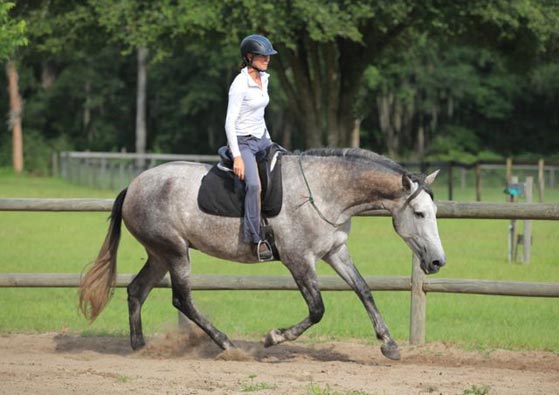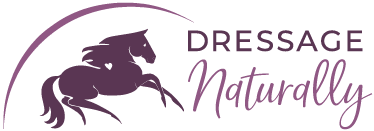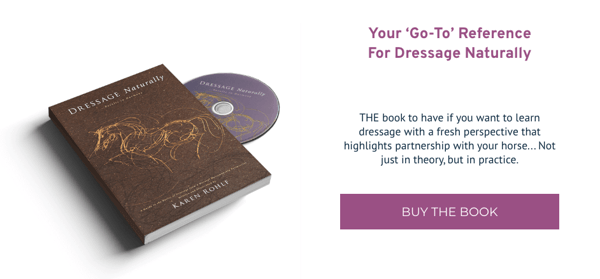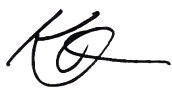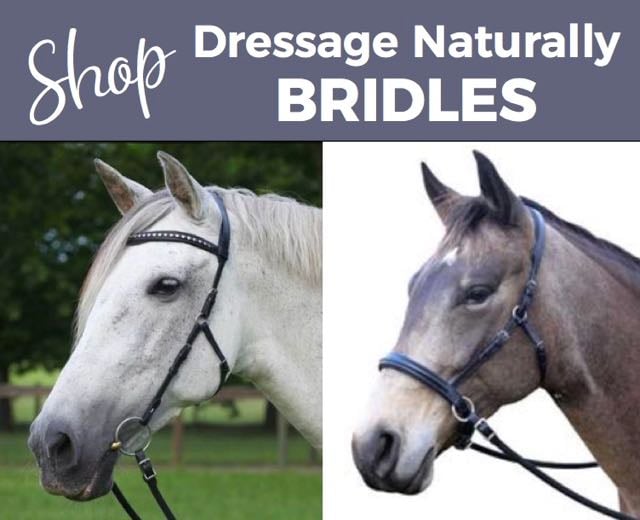Is Bitless A Viable Option For 'Real' Dressage?
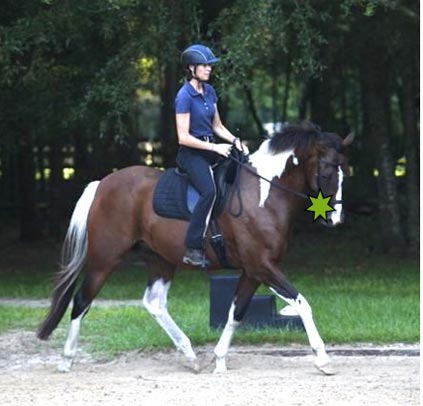
NOTE: This is a long read, but totally worth it. If you want to listen to it go to Episode 7 of my Horses In Harmony Podcast on my website, or wherever you listen to podcasts!
People often fit into one of these two categories: People who are against using bits, and those that believe that you can’t get ‘real’ results without a bit. It usually isn’t a problem, the bit-less believers do their thing, and the bit believers do their thing. It gets interesting when they both want to do the same thing... And it gets very interesting when the thing they want to do is dressage. I know because I am right in the middle of it.
It can be a hot-button subject with people who use bits arguing fiercely against people who don't and vice versa. I can speak from decades of experience training horses to the upper levels of dressage - both with bits and without. I am both pro-bit and pro-bitless without being against either. It's ultimately up to the individual horse.
This article seeks to shed some light on the pros, cons, and uses of some tools we have available. This topic also requires that we ask ourselves what we are really doing in dressage. After all, it is easier to know what tools to use if you have a very clear idea of what you are trying to create. Hopefully it will spark some questioning about whether the current rules of competition truly reflect what we would like to do in dressage.
My Background
Why should you listen to me? I think you need to listen to your horse more than me, but let me share a little about myself so you understand my perspective on this subject.
I started as a little kid who learned to ride bareback, and in a halter. I then received formal dressage training with International rider, trainer, and judge, Anne Gribbons, who I studied with, then trained alongside as a professional for about 25 years. I have competed in all levels, Training through Grand Prix. I represented the USA in the NAYRC 4 times, graduated the USDF ‘L’ judge program with distinction, and was accepted into the USEF ‘r’ judge program. I developed students and horses from zero through FEI. I later immersed in ‘natural horsemanship’ which expanded my range of ways to view a horse, and options for talking to them, which included liberty and bridle-less.
Now, in my Dressage, Naturally system I move freely between bits or no bits depending on the horse, with the ultimate goal still being dressage; the good kind... The kind that is about harmonious education, happy athletes, healthy biomechanics, and the partnership between horse and rider.
This description of my history may have already triggered some reactions. There is a huge range of images you may get from the term 'natural horsemanship', and there is a huge range of images you may get from the term 'dressage'. So to keep it simple, let's say that I put a priority on creating happy horses with healthy movement.
I don't 'sack horses out' in round pens, or flop around with bad biomechanics. I don't have side-reins or draw-reins in my tack room, and I don't do rollkur.
Let's also establish that neither bit-less or bitted is inherently more gentle or harsh than the other; it is totally dependent on the heart and hands that are at the other end of the reins. It is possible to be cruel and unfair in a rope halter, (or regular halter for that matter), and it is possible to have the most magical and gentle connection in a double bridle.
Neither bit-less or bitted is inherently more gentle or harsh than the other; it is totally dependent on the heart and hands that are at the other end of the reins.
The Tools Of Dressage
As far as disciplines go, dressage has some of the most gentle, horse-friendly rules regarding bits that are allowed, and I really respect that. Not every rider uses the equipment well, but at least the rules are written in a way that sounds nice. I think some of the basic intentions regarding the bit and contact really need to be refreshed in our minds. I will attempt to give my vision of the contact and my humble opinion about what 'real dressage' is, as I think it is critical to making a decision about whether bit-less is a viable option.
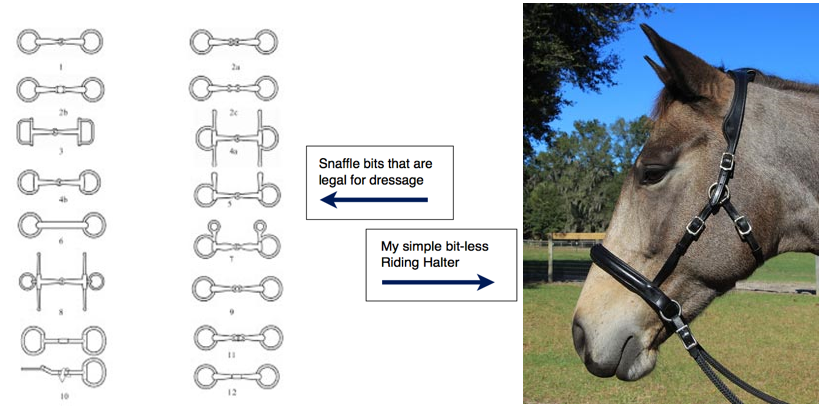
To be clear, when I describe bit-less I personally am referring to simple 'side-pulls' (yuck - I really don't like that term) with no leverage, and no cross over straps.
 The bitless I designed (pictured above) is a simple, comfortable nose-piece with reins attached on the side, with no leverage, and is made so the nose piece does not have to be tight on the horse in order to fit and be secure; it will not twist into the horse's eye. I call it a riding halter because I don't like the term 'side pull'. (You can purchase or learn more about it in my webshop)
The bitless I designed (pictured above) is a simple, comfortable nose-piece with reins attached on the side, with no leverage, and is made so the nose piece does not have to be tight on the horse in order to fit and be secure; it will not twist into the horse's eye. I call it a riding halter because I don't like the term 'side pull'. (You can purchase or learn more about it in my webshop)
Yes, You CAN Do Dressage Bitless
It is totally possible to do completely correct dressage up through Grand Prix without a bit. Some horses will do it better without a bit, and some will do it better with one, depending on their particular comfort level in carrying a bit.
Arguments From Both Sides
Let’s look at some of the common arguments for and against bits. For the sake of this article, let’s assume we are talking about well fitting equipment that is legal for dressage competition, and equivalent type bit-less bridles (no sharp parts or twisted wires, or leverage of any kind, etc). Let’s also assume they are in the hands of competent horsemen. I never like to judge a technique based on how it is done by someone without skills, so let’s imagine it being done with a skilled rider so we can really isolate the use of the equipment itself.
Common arguments I have heard against riding with a bit
(And my humble responses to them):"Bits are painful to the horse"... Not necessarily, if selected, fitted, and used correctly. Some horses never feel comfortable in a bit even if they aren't necessarily in pain. Some horses practically put the bit in their mouths themselves when you come with the bridle!
"Bits are harmful to the horse"...Not necessarily, if selected, fitted and used correctly. I agree, though, that the potential for physical damage is greater with a bit due to the delicate nature of the tissues in the mouth, and the sensitivity of the Temporomandibular Joint.
"Bits are not necessary"... I agree. A bit is a tool of refinement, which means it should take something that is working well and make it feel even better. So no, they are not necessary, but for some horses a bit offers a level of refinement that is too amazing to miss!
"It puts too much pressure on the delicate mouth when you take contact to ask the horse to be 'round'."... I agree that happens when you take contact. In an excellent, healthy contact, it is the horse who should be taking it. This kind of contact can feel amazing and is an honor to feel, because the horse is trusting your hands with his mouth; the hands just receive the feel that the horse offers. The roundness and softness in the jaw and poll ought to happen as a result of a horse moving in balance and self-carriage. The balance is so good, and the rider's hands are so trust-worthy that the horse allows himself to go in this posture of trust. To take the contact and pull the head into a 'round shape' is not the role of correct dressage contact.
Whether bitted or bit-less, the contact must be excellent and achieved as a result of the balance of the horse.
Whether bitted or bit-less, the contact must be excellent and achieved as a result of the balance of the horse. In my experience many horses who are described as 'hard-mouthed' are horses who have experienced too much contact and they brace their jaws, necks, and shoulders to protect themselves. Too often the 'logic' of the rider is to put a 'stronger' bit on, which just perpetuates the problem... (Oops, I was supposed to be talking only about skilled riders!). For the record, a horse or rider that leans on a bit-less bridle can also cause damage due to the contracting of the neck that can still happen.
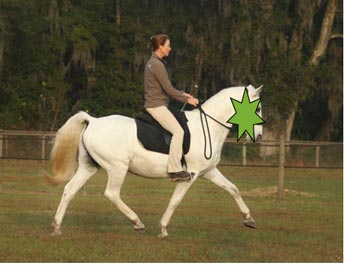 |
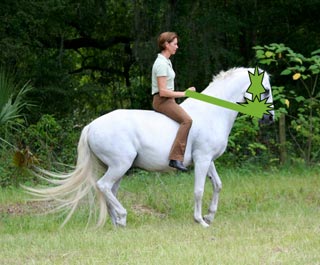 |
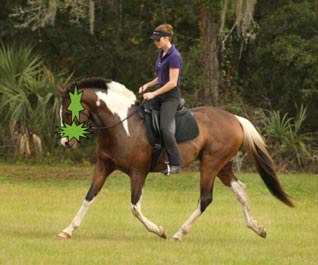 |
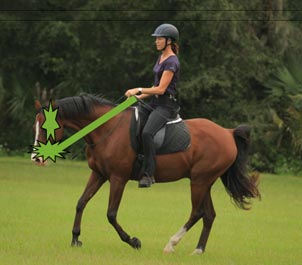 |
Common arguments against bit-less dressage
(And my humble responses to them):"You can't achieve real collection without a bit"... I strongly disagree. Horses can collect themselves all by themselves. Dressage is about enhancing movement that is natural to a horse. Nowhere in Article 417 of the F.E.I rule book describing collection, does it even mention a bit or the contact. I realize that earlier, in Article 401 it states that all horses need to be 'on the bit' and I'll talk a bit about that further along in this essay, but I think it is clear that collection is primarily about the body and balance of the horse. It is fair to say competitive dressage has decided that contact with the bit is something they want to be able to judge, but it is not fair to say that it is required in order to meet the description of what collection is. This is a big subject... Hang in there, I'll come back to it!
Article 417:
The aim of the collection of the Horse is: a) To further develop and improve the balance and equilibrium of the Horse, which has been more or less displaced by the additional weight of the Athlete. b) To develop and increase the Horse's ability to lower and engage its hindquarters for the benefit of the lightness and mobility of its forehand. c) To add to the “ease and carriage” of the Horse and to make it more pleasurable to ride.
"Dressage is all about the contact with the horse's mouth."... I strongly disagree. Dressage is about biomechanics and communication. The quality of the biomechanics and communication will show up in the reins, and it is certainly part of the circuit of energy, but it is not the main part of dressage. Issues of the body will show up in the contact, and issues caused by bad contact can inhibit what is trying to happen in the body, but that doesn't make "dressage all about the contact".
"You can't judge dressage unless there is a bit in the mouth because it is the most important part of dressage. Without a bit, it is not real dressage."... Unfortunately it may indeed be true based on today's rules for judging, but we can still debate whether 'today's rules' are the determination of what makes 'real dressage'. Keep in mind that the Dutch spent 3 years testing bitless in competitions and decided there was no reason not to allow it. So as of April 1, 2014 they allow it in the lower levels.
I just have a hard time believing that the bit is the most important part of dressage. I do agree that contact and connection through the reins is an important piece of the horse/rider connection; for me it just doesn't have to be in the mouth.
Rules For Judging
The Current USEF Rules for Judging state the following should be kept in mind when arriving at scores (This is based on Article 401 of the F.E.I. rules for dressage):
- The object of dressage is the development of the horse into a happy athlete through harmonious education. As a result, it makes the horse calm, supple, loose and flexible, but also confident, attentive and keen, thus achieving perfect understanding with the rider.
- These qualities are demonstrated by:
a. The freedom and regularity of the gaits;
b. The harmony, lightness and ease of the movements;
c. The lightness of the forehand and the engagement of the hindquarters, originating from a lively impulsion;
d. The acceptance of the bit, with submissiveness/throughness (Durchlässigkeit) without any tension or resistance.
In order for bit-less to comply with the rules, all that would need to happen is to change the word 'bit' to 'reins'. The acceptance of the bit is just one part of one part, of what is looked for. It doesnt' even get its own sentence here, but is intimately wrapped up with throughness, and lack of tension or resistance. With or without a bit, lack of throughness, tension or resistance will be apparent. I really have a hard time believing that a judge would not be able to tell how good the performance of the horse is if he was unable to see the horse's muzzle.
This brings me to my biggest question to today's dressage: If contact with the bit is so important in judging 'real' dressage, then why are nosebands allowed? Take off the nosebands and you will learn a lot more about the contact.
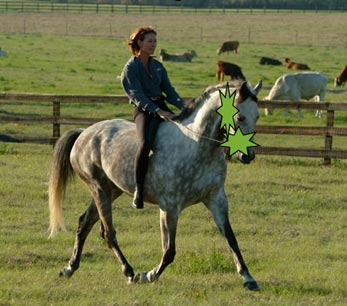 |
 |
"You can’t talk to the horse directly to soften his jaw without a bit.”...Yes, and... Even though it is the one conversation you cannot directly have without a bit, you can still influence the jaw indirectly by eliminating the reasons for tension in their jaw that comes from their minds, bodies, and the rider's hands.
Keep in mind also, that much of the tension in horses' jaws are created by uncomfortable, or poor use of bits. Most supposed 'jaw suppling techniques' I see being used are not really suppling the horses' jaws and would likely cause a gaping mouth if the noseband were not on.
The technique to actually soften and relax the jaw is a specific move which involves raising the hand up and forward, so the bit acts upwardly in line with the line of the mouth, not against the jaw. This puts no pressure on the jaw itself, and so creates no additional tension or brace reflex. It causes the horse to unclench his jaw, allowing a relaxed release and opening of the mouth. I rarely see this technique used in 'normal' dressage. Philippe Karl teaches this well.
If I am riding a horse without a bit and there is tension in the jaw that is the source of problems with his biomechanics, I will choose to use a bit to help him relax his jaw. Some horses have formed habits of tensing their jaw or holding tension there even once the reason for it is gone, the same way humans may need to be reminded to breathe or relax. In reality, this is a small percentage of cases, and is usually used for moments of refinement. Most jaw tension arises from the bit itself, or somewhere else in the body/mind. If the horse has tension in his jaw and the source of that tension is imbalance in his body or mental anxiety, then I don't need a bit; I need to solve his balance and anxiety issues.
If the horse is fine bit-less, and the tension shows up in his jaw only when there is a bit in his mouth, then I may realize that the bit and bit alone is the cause of the tension. This is the horse that is a candidate for bit-less option.
"Riding bit-less allows the horse to tolerate bad hands, so riders will not develop good hands." ... Yes and no.
Yes, the nose is not as sensitive as the mouth, but for the lower levels or young horses we could look at it the same way we look at allowing rising trot. Some young horses with some riders feel better at the rising trot, some feel better sitting. Rising trot is allowed much more in the lower levels than it used to be, because not every young horse or inexperienced rider can deal with sitting trot in a healthy, happy way. Did the dressage world say that "riders will not learn how to sit the trot if we allow rising throughout Training and First Level"? No, it was agreed that it was a nice way to allow horses and riders to feel more comfort and ease of movement and therefore confidence, to set them up for later. At the very least you could consider bit-less in this way as a nice thing to do for the lower levels. (Then later I will do a push for extending that courtesy for upper level horses too!) :-)
Upon hearing the arguments against bit-less, I have some questions:
1. If quality of the contact is such an important thing to judge, why are nosebands allowed? Nosebands (try to) hide what is going on in the mouth. From a training perspective, if your horse 'needs a noseband' because he is evading the bit, the trainer needs to be motivated to solve the reason for the evasion rather than simply covering it up. I realize that not all people use tight nosebands, and there will be talk about how it 'stabilizes the bit' in the horse's mouth, etc. Nosebands are another article in itself, so I will try to control myself here, but the bottom line is that if you say 'dressage is about the contact with the bit', then the rules should be such that the judges can really be able to assess the quality of the contact by not allowing nosebands.
2. If you say that 'you cannot achieve real collection without a bit', then are you saying that riding bit-less is a disadvantage? Then why not allow it, and the scores will work themselves out.
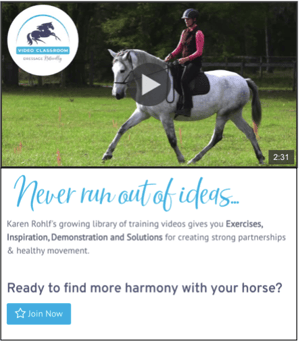 3. If you say that 'riding bit-less allows horses to more comfortably tolerate bad hands" and it avoids the requirement of acceptance of the bit, then are you saying that riding bit-less is an advantage. Are you saying that there could be a situation where if someone riding bitless scored higher than you, he would have scored lower if only the horse could feel how bad the rider's hands were? To me, the biomechanics and the movements will tell the real story. A judge will be able to tell the bad hands from the good, and the really bad hands in a bit-less bridle will still mess up the quality of the dressage (the gaits, the movements, etc) just as much as they will in a bit. Besides, if the rider's hands are that unsteady, isn't it just a very wise decision to go bitless (the same as it is wise to choose to rise at the trot, or not use spurs if your leg is unsteady)? The rider score will give the judge an opportunity to mark down any 'bad riding'.
3. If you say that 'riding bit-less allows horses to more comfortably tolerate bad hands" and it avoids the requirement of acceptance of the bit, then are you saying that riding bit-less is an advantage. Are you saying that there could be a situation where if someone riding bitless scored higher than you, he would have scored lower if only the horse could feel how bad the rider's hands were? To me, the biomechanics and the movements will tell the real story. A judge will be able to tell the bad hands from the good, and the really bad hands in a bit-less bridle will still mess up the quality of the dressage (the gaits, the movements, etc) just as much as they will in a bit. Besides, if the rider's hands are that unsteady, isn't it just a very wise decision to go bitless (the same as it is wise to choose to rise at the trot, or not use spurs if your leg is unsteady)? The rider score will give the judge an opportunity to mark down any 'bad riding'.
4. Is it an advantage or disadvantage? When I ask people who are 'against bit-less' they usually mention all of the above arguments, so what is interesting is they conflict themselves regarding whether bit-less is an advantage or disadvantage. If you can't figure out whether doing dressage bitless is an advantage or disadvantage then it is neither or both, and so it doesn't matter!
If you can't figure out whether doing dressage bitless is an advantage or disadvantage then it is neither or both, and so it doesn't matter!
5. If dressage really is all about judging the contact with the horse's mouth, then why are nosebands allowed? Oh wait, I already asked that. It was worth repeating.
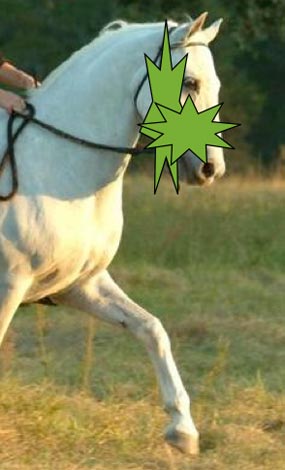
Some more thoughts about dressage, posture, and the contact:
First, let's look to the FEI rule book. In Article 401 we learn that: The object of Dressage is the development of the Horse into a happy Athlete through harmonious education. As a result, it makes the Horse calm, supple, loose and flexible, but also confident, attentive and keen, thus achieving perfect understanding with the Athlete.
I live by this objective. Notice there is no mention of bits. Article 401 then goes on to say that: The above qualities are demonstrated by 4 things, one of which is: The acceptance of the bit, with submissiveness/throughness (Durchlässigkeit) without any tension or resistance.
Of the six points under the general object of dressage, only one mentions the bit, and it does so in quotes: "on the bit".
According to the FEI rules: "A Horse is said to be "on the bit" when the neck is more or less raised and arched according to the stage of training and the extension or collection of the pace, accepting the bridle with a light and consistent soft submissive contact. The head should remain in a steady position, as a rule slightly in front of the vertical, with a supple poll as the highest point of the neck, and no resistance should be offered to the Athlete."
All that would have to change would be to say: "On the contact", and everyone could be happy.
Later in Article 408 it talks about the all important Half Halt and the words bit or bridle aren’t used at all; It is clearly concerned with biomechanics. There is just one mention of the rider’s hands: "The half halt is an almost simultaneous, coordinated action of the seat, the legs and the hands of the Athlete, with the object of increasing the attention and balance of the Horse before the execution of the movements or transitions to lower and higher paces. By shifting slightly more weight onto the Horse's hindquarters, the engagement of the hind legs and the balance on the haunches are improved for the benefit of the lightness of the forehand and the Horse's balance as a whole."
Article 416 of the FEI rulebook talks about submission in 6 bullet points, and only one of which mentions acceptance of the bit. But, the section finishes with this reminder about submission: The first thought when considering submission is willingness, that the Horse understands what is being asked of it and is confident enough in the Athlete to react to the aids without fear or tension. That can surely be achieved and assessed even without a bit.
So yes, I suppose the way the rules are written, you would not be able to judge the acceptance of the bit without a bit. But imagine if the word 'bit' could be changed to 'contact' or 'reins'. I have every confidence that a judge would be able to tell the difference between a horse/rider pair that has a dynamic of excellent submission and connection through the reins (whether or not attached to a bit), with one that doesn't.
What is 'Real' dressage (according to me)?:
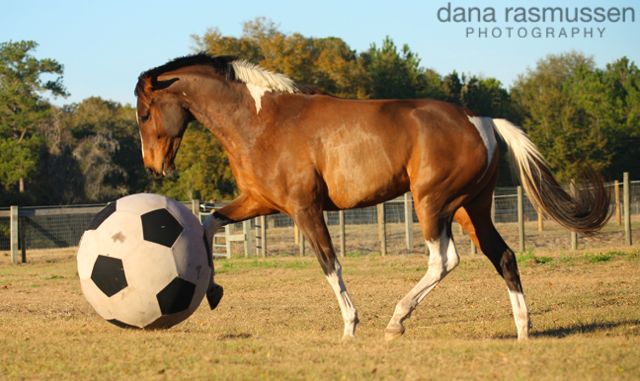
Biomechanics is a result of posture, and posture is a result of... Everything. Posture is not just about the head, neck, and tracking up, although these are often the easiest things to see. The mental and emotional state hugely effect posture.
Think of the posture of a teenage boy doing something he doesn't want to do, or a teenage girl who feels unconfident or scared. Now imagine someone physically putting that apathetic teenager's body parts in the shape of excellent, athletic posture. Imagine using your hands to put their heads straight up, or to pull their shoulders back. Chances are they won't stay there. You could tie them there, or use duct tape, but that would be ridiculous, right? We know that to improve the posture of that teenage boy or girl we would need to get them inspired by doing an activity that they love and feel confident doing. Their posture would change completely if they were enjoying it or wanted to be doing it!
We need to train the horse’s body and mind first, and ride from back to front, with hands that wait to receive the contact... But that is getting off topic because that technique can work with or without a bit.
(Enjoy the short video below about the biomechanics of a happy vs unhappy athlete...
This article continues below that.)
Roundness comes through balance, and balance comes through movement. I say this to emphasize that the quality of the contact is a result of the quality of the balance of the body - not the other way around.
As a trainer, I don't want a neck that is rounder than the body. The neck is so flexible and I have experienced the biggest training issues with horses that have learned to disconnect their necks from the rest of their bodies. If their backs are flat, of course their necks will not be soft and round. If I make the neck soft and round through manipulating the neck only, I am teaching the horse to disconnect his neck from his body, and that is the more difficult problem to correct. A horse that is too light and curled in his neck is trickier to improve than a horse that is a little high and strong in his neck.
Having a more powerful tool at the end of the reins (a bit) could make it easier to hide issues of the balance. With a bit it is easier to make the neck rounder on a horse that is stiff in his back... That is, it's easier to make the neck 'rounder' than the rest of the horse. Maybe that is an advantage for the competitor if they are hoping that the judge will be fooled (but hoping for an incompetent judge doesn't sound like an advantageous situation for the sport in general).
Honoring the sensitivity of the mouth
What needs to be assessed regarding contact with the bit, is that the horse is remaining calm, open, trusting, with an uncontracted neck even with a piece of metal in his mouth.
To think of it this way honors our connection with the horse in this very sensitive and intimate area of the horse. It values the refinement involved in attaining this amazing connection. It reminds us that in dressage, bits are not meant for control, but for sophisticated communication. Maybe this is what dressage does not want to give up... The striving for this sophisticated, refined art of connection with the bit. But again, if that was really the case... If that was really the argument against bit-less, then dressage better clean up its own act regarding what is tolerated regarding the contact that many horses are enduring. Did I mention yet about not allowing nosebands? Yeah, I think I did.
Dressage better clean up its own act regarding what is tolerated regarding the contact that many horses are enduring.
A bit is a tool of refinement. A tool of refinement takes something that is already working well and makes it work better. If I am on a horse that is difficult to control, I don't want to be getting into his mouth. Negative pressure in the mouth usually causes anxiety which makes matters worse. Imagine someone pulling you along by your arm... It's not too bad. Now imagine someone about to pull you along while holding onto your lip. If you really imagine it, I'll bet you just tensed up your neck. From a training point of view, if I have a horse that is difficult to control I am going to go back as many steps as I need to solve the underlying issues. Those issues most likely are not with his mouth.
It's the horse that is supposed to take the contact. If a horse is balanced through movement, then his top line can relax and be used for locomotion and not support. When this happens the neck will reach out of the withers and if he both trusts and respects the length of the reins, he will meet the rider's waiting hands. The 'round' posture is something that arrives when the balance and trust is there. If a rider takes backwards it acts on the horse's jaw, causing contraction of the neck, opening of the jaw, tensing of the jaw or protecting the jaw by going either too curled or too high.
All those issues will show up if you are bit-less too. The only one that won't show up is the gaping of the jaw since there is no bit (although under negative tension on the reins, many horses will open their mouths even without a bit).
Some horses really don’t like bits.
If you train enough horses, you will find the horse that has trouble getting comfortable in the bit. You try different styles, different nosebands, but the contact is still an issue. It actually seems to make training him more difficult. When you start a horse without a bit you get to know the horse in a way that you can better diagnose when a bit is causing problems with the training, or the training is causing problems with the bit.
I start all my horses bit-less and when they are going confidently walk trot and canter in biomechanically good working gaits in connection with the reins (they are ‘round’ and look ‘on the bit’), able to stretch in balance and do leg yields I start introducing the bit. For most horses this makes a good thing even better, for some they feel the same, and for some things get worse.
Some horses really hate the feeling of a bit on their tongue. With these horses, just wearing the bit causes tension, and that tension becomes the dominant distraction from doing dressage. I have horses that would have a completely different set of issues if the only context I knew them in was with a bit. Without a bit, their training progressed faster. With a bit their training got distracted. Believe me, I continually question: if I only found the right bit, or if only I could prepare and educate them better, perhaps it would work better, but I do that with every aspect of my training... And meanwhile I want them to progress.
If I get to Grand Prix and they still don’t accept a bit... That’s OK, I can live with that. To put them in a piece of equipment that I have to train against every day... I cannot live with that. Since I am not so interested in competing anymore I am lucky to have the freedom to choose, and still feel that if any dressage judge visited me on any given day, they would be able to positively assess their biomechanics and skills with dressage according to the agreed upon criteria for the movements. In other words, if you just let your eyes go a bit unfocused in the muzzle area of my horse, you would be able to critique me just fine.
This brings me to another point. I am sure some of you reading this will be looking over my horses and my position and will be able to offer all kinds of criticism and find all kinds of ways that I am not the perfect embodiment of perfection. Don't worry, I am aware of my imperfections. I get help, I take lessons, I am always striving to improve... I just don't think putting a noseband on or a bit on is the most important thing standing between me and perfection.
Some examples from my current personal horses...
Now I want to share some of my horses with you and why I use the equipment I do with them. All my horses are started in a light rope halter. I make sure they can be ridden with a loose rein walk trot and canter in an arena and out in the open. I do the basics of connection with the reins and posture work, creating enough balance to carry themselves, be balanced enough to be stretchable, yet respect the length of the reins. They are comfortable in their working gaits. At the same time, as they are doing their working gaits, I have found a bit they find the most comfortable. They practice carrying the bit until they go exactly the same when carrying the bit (no reins attached) as they do when they are not carrying the bit. On the good days, where it is most likely there won't be brace or imbalance in the reins, I start establishing a connection with the bit. Once they are comfortable with that, I reassess my bit choice depending on what they are telling me with the contact. If all goes well they continue on, checking often that I can still ride on a loose rein (so my reins are just for communication, not control). I also always want to be able to ride bit-less and do much of the training that way. The bit is used for refinement, and on a schedule that works best for the horse so I can preserve communication, trust, and seat connection.
Monty (Lippizan): No problem with bits or bit-less
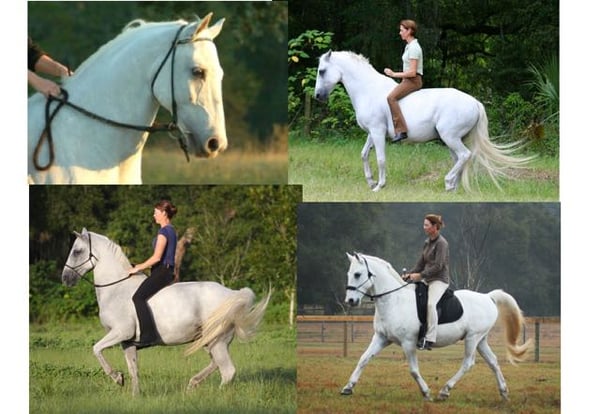
Monty was perfect. He could flow between bridle-less, bit-less, and with a bit (never a noseband) on a daily basis. I used bit-less to train, and the bit to refine. I miss Monty.
Ovation (Paint/Holsteiner): Does not like snaffles
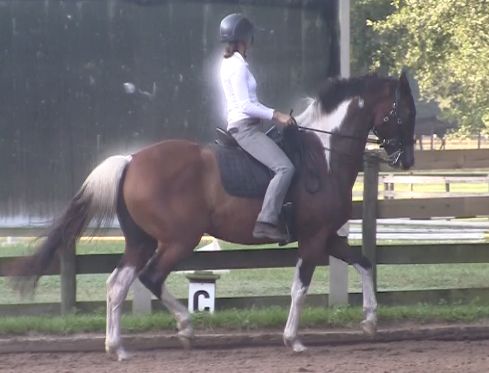 |
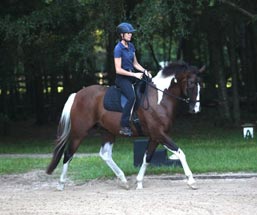 |
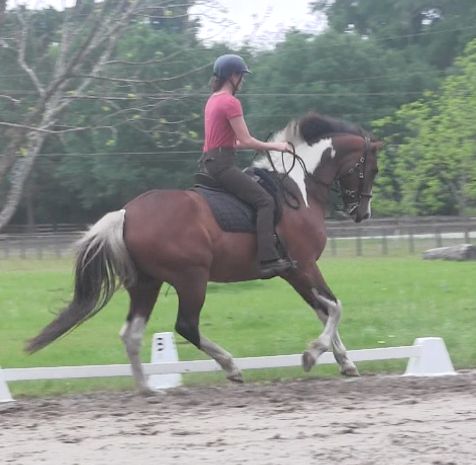 |
 |
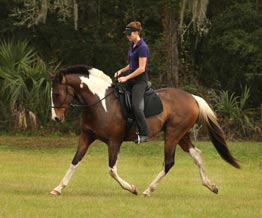 |
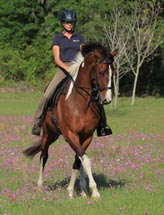 |
Ovation is a pushy type horse, very strong with his neck and head. I started him as I normally do, in the halter. He was an easy start, but it was clear his personality did not help his biomechanics. He is not naturally motivated to go forward, has a huge swingy hindleg and little tendency to lighten his forehand. These factors made it a challenge for him to find nice working gaits. To be perfectly honest, part of me was secretly looking forward to the moment where I would put the bit on him because his tendency was to be heavy in the reins and he loved trying to lean his body weight forward into them. But I stayed with my plan and made sure he was motivated, responsive to my seat, and respectful of the length of my reins. When he reliably found self-carriage in his working gaits in an energetic balance and was stretchable, I started riding him more in the snaffle. He had been carrying one for a while, I'd had a hard time finding a snaffle he found comfortable. I tried about every type of dressage-legal snaffle, and also tried wrapping each one in rubber, but no matter what I did, he would suck his tongue up his mouth, contract his neck, and break out in a cold sweat. He finally got so he could carry it without too much added tension, and on the good days when his self carriage and balance was super, I would use the reins attached to the bit, and would be thrilled if I could even feel an ounce or two of contact without tension. When in the bit, this normally mellow horse could also become spooky.
His biomechanics were challenged when using the bit due to the tension in his neck and mouth created by the bit. I continued to develop his balance and collection in the halter, with the idea that if he never lost his balance he would never have too much pressure in his mouth via the bit, and so would have no reason to be tense. It was progressing, but it still felt like riding him in a bit was like trying to do dressage with both my hands tied behind my back (which I could sort of do on Monty, but he was amazing). I finally just listened to him and my instincts, and forgot about the snaffle. For those who may be thinking that I just needed to let him get used to it more, you'll just have to believe that I gave it years. I switched to a more comfortable bit-less bridle for him to sustain contact with (the rope halter was too sharp for him; Ovation likes consistent, steady, comfy connection...) The bitless I use is pictured at the top of this article, next to the illustration of the bits.
This immediately accelerated our dressage progress as everyday was a better day connecting without tension. As we advanced, we met another issue: In learning flying changes he discovered 'hand-stands'. He was able to use his dominant neck to effectively evade my efforts of teaching the flying change. We needed to go back and get our canter even better, and increase the degree of collection in general. All was improving, but still in certain moments I couldn't get to his hind end because of this very effective evasion he had! He figured out how to (rather dramatically) throw his neck down to take the weight off his hind end. The neck was not a symptom in this moment, it was the problem. I found that I wanted the refined and clear communication about elevating the poll (not throwing me over his head) in the moment I needed it, without increasing the general contact I had all the time (which was lovely), and risking contracting his neck. That can be done so sweetly in a double bridle, because you are leaving the curb alone most of the time. I found a curb bit that he actually found comfortable! It is the Sprenger KK curb with an angled port so that at rest it sits away from his tongue. It also has short shanks, so not a lot of leverage. Add a nice rubber pad under the chin and we were good to go! He shows no objection to this bit, so he now goes in my bit-less halter with that curb hung on it. He can stay consistent in his contact through the bit-less, yet I have some light communication about elevation! Ta Da! This allowed me to be light and effective in a way that he understood and was comfortable with. We are schooling 4th level now, with some piaffe and passage well under way [Update: Grand Prix!]. I still can ride him in just the bit-less if I like,.
Natilla (P.R.E.): No problem with bits or bitless
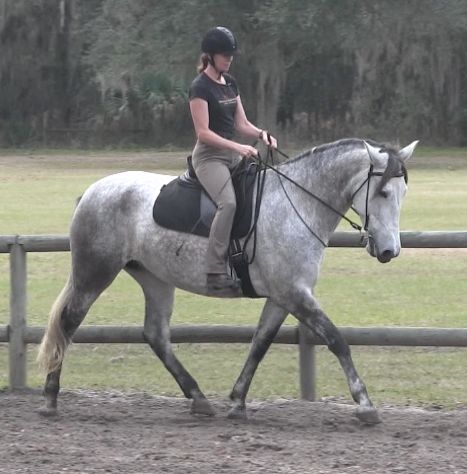 |
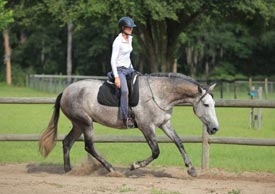 |
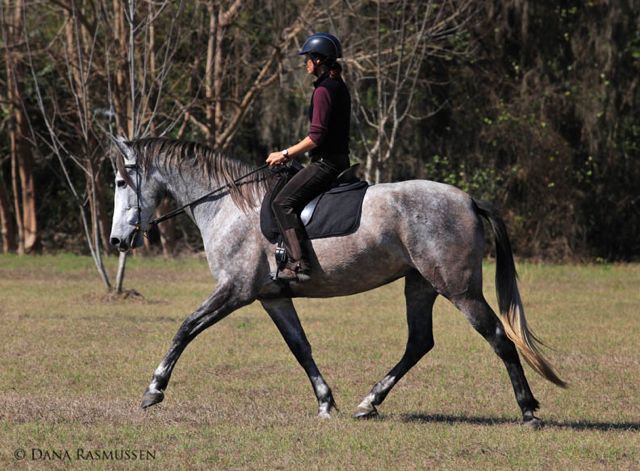 |
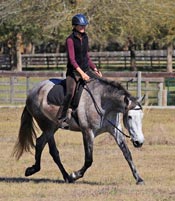 |
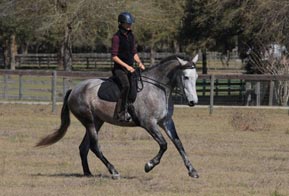 |
Natilla is young, (pictures of her above are from age 4 and 5). She was started in the halter, introduced to the bit with no problem and now feels equally good bit-less or in a snaffle. I have never used a noseband except for a simple cavesson adjusted loosely for decoration when we did a competition. She has no mouth issues and carries her mouth quietly and softly closed
Solana (P.R.E./Kiger Mustang/Oldenberg): Does not like snaffles
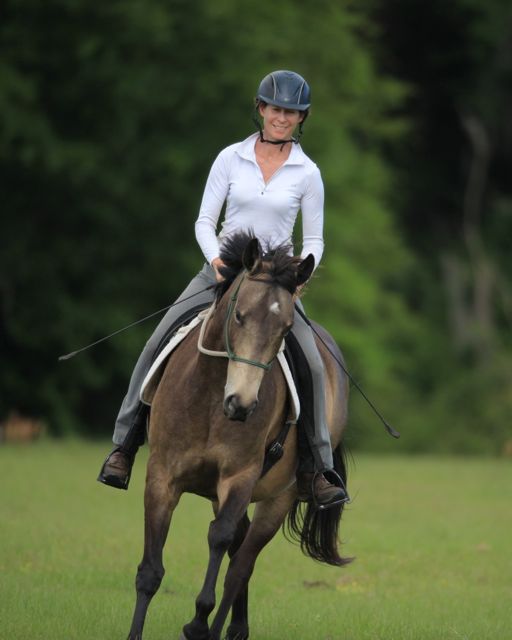 |
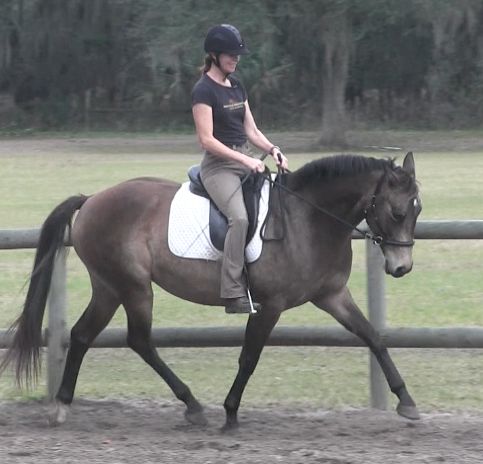 |
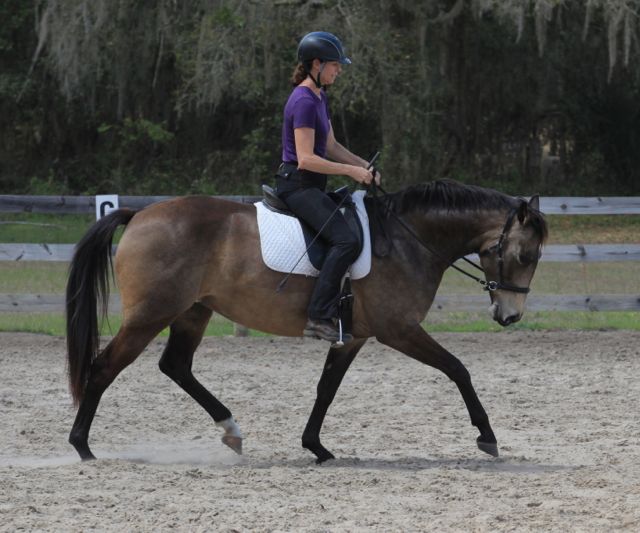 |
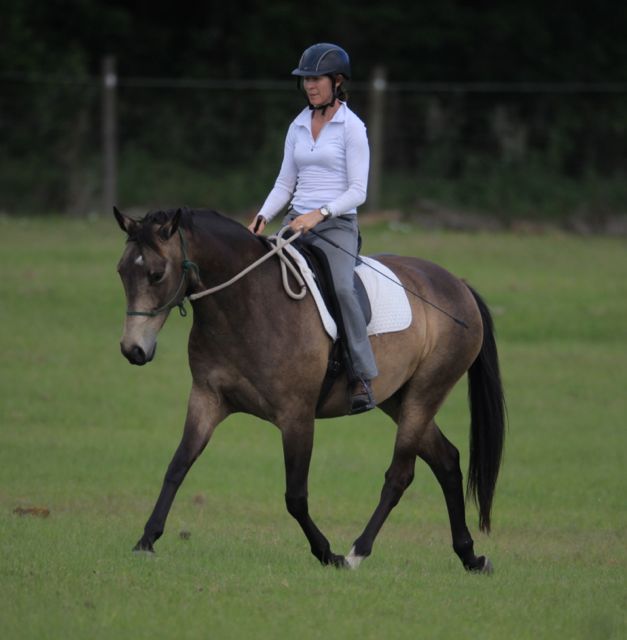 |
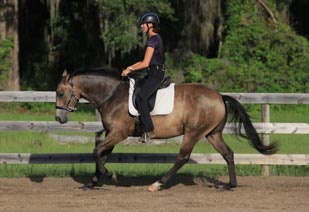 |
Solana is pictured above at age 4. At the writing of this article she just turned 5. She was started like the others in a rope halter, and introduced to a bit. This all went fairly well, but even when just carrying the bit I noticed she liked to pull it up in her molars and grab it. She chewed through a couple rubber bits. I tried narrower and thicker, egg-butts, mullen mouths, singe jointed, double jointed, heavier or hollow. Her reflex when in a bit was to either grab it in her molars and lean down, or become too soft and avoid it by curling behind the contact. In the halter she was respectful and progressing well. She has a sort of blocky body type that is not naturally flexible laterally, so I spent time in the halter opening her body and finding some more flexibility and throughness in general, then tried the bit again. She would politely take the bit, but during the rides would become completely preoccupied with the bit. When this happens I cannot find the same relaxation, power, and throughness in her body that I can without the bit. The bit was getting in the way of our dressage. Now I ride her in my bitless riding halter and she is lovely. My plan is to continue to introduce the bit to her at various times in her development to see if I can ever use it as a tool of refinement, but meanwhile her biomechanics and dressage are coming along just lovely and she is an excellent willing partner!
I have 3 other horses, each who can be ridden with or without a bit. So, for my 6 current horses, only 2 have issues with bits. I am fairly confident that the horses with bit issues are not a result of a flawed system in general.
In Conclusion...
I hope this sheds some light on the logic that can be used for making decisions between bitted and bit-less. There is not a lot of information out there from someone who is currently training using both bitted and bitless options and is striving for dressage. I hear the opinions from both sides. People can be too quick to dismiss all their options, without enough practical experience behind their decision. Rules for competitions only perpetuate this lack of flexibility that could serve the horse. I have learned to listen to the horse and to my instincts. As far as changing the rules for dressage: I hope they do allow bit-less. I realize doing this won't change the world. There will be people who misuse bit-less or will use it so their horses can tolerate their bad hands, the same way there are people who will misuse a bit to make their horse's nec round even though their body is out of balance, or will use a spur to make their horse go because he doesn't listen to their legs.
The best we can do is keep a clear picture of what we are really trying to achieve, to remember to act out of love for the horse, to be gentle in our process, to do our best, and help others do their best. Dressage competition should reflect and serve the best horsemanship. Horsemanship should not have to compromise itself to serve imperfect rules. Judging needs to focus on the heart of the matter, and not miss the forest for the trees. In my humble opinion.
--------------------------------------------------------------------------------------------------------------------------------
Below are repeats of the photos used throughout this article, but now with their heads exposed so you can see what they are being ridden in.
Thank you to photographers: Dana Rasmussen, Terri Miller, Coco, and Peggy Finnerty
-----------------------------------------------------------------------------------------------------
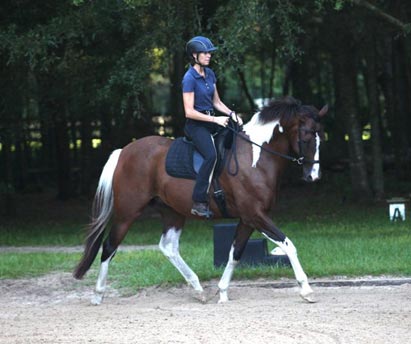 |
 |
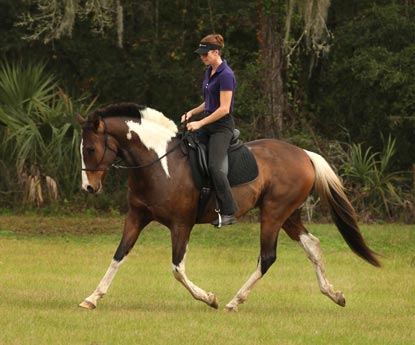 |
 |
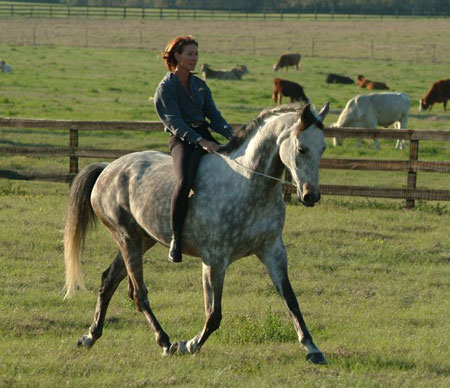 |
 |
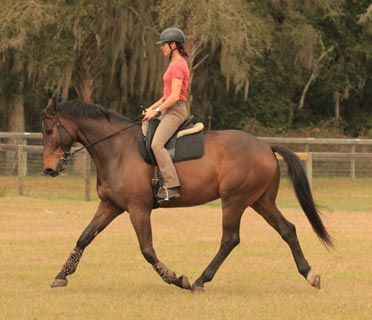 |
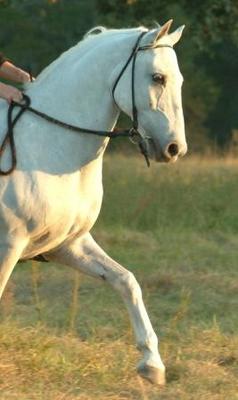 |
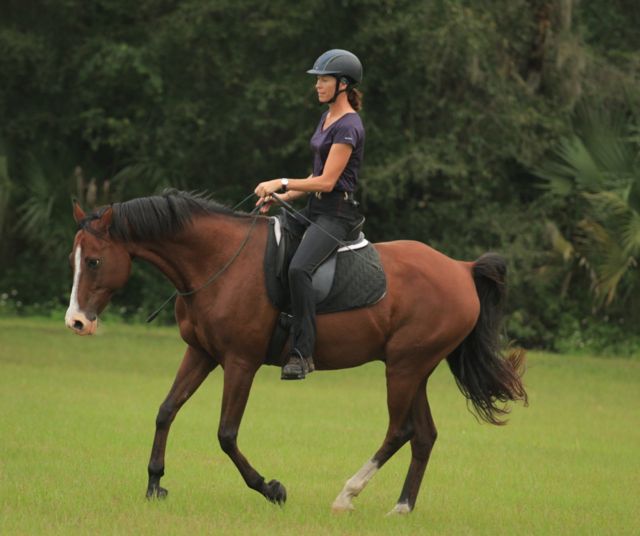 |
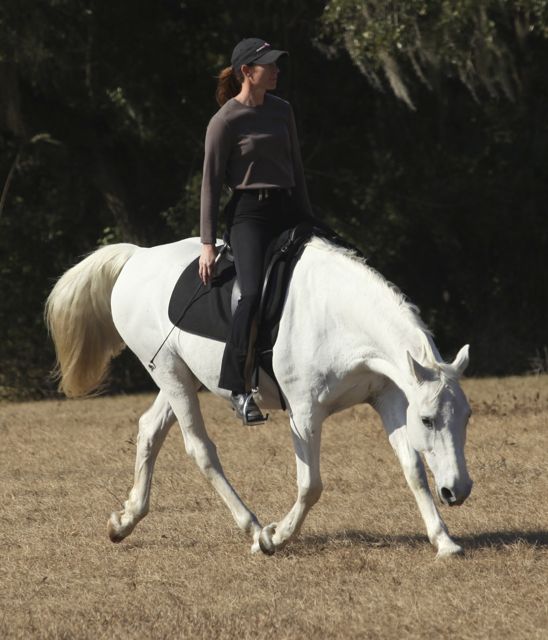 |
 |
 |
 |
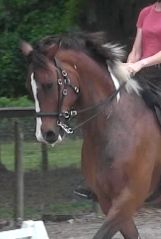 |
